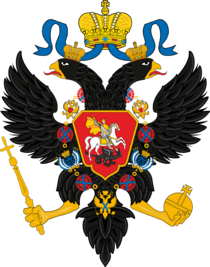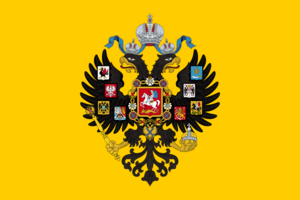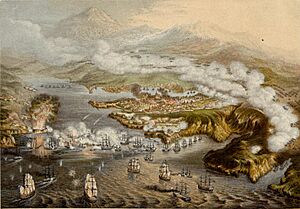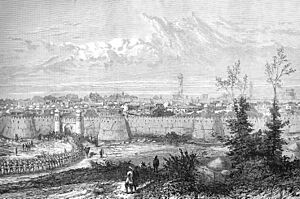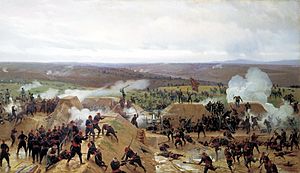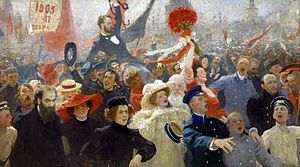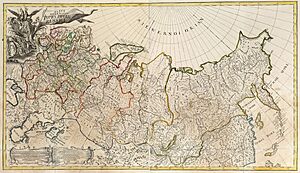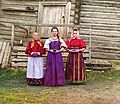Russian Empire facts for kids
Quick facts for kids
Russian Empire
|
|||||||||
|---|---|---|---|---|---|---|---|---|---|
|
Motto: Съ Нами Богъ!
"God is with us!" |
|||||||||
|
Anthem: «Боже, Царя храни!»
("God Save the Tsar!"; 1833–1917) |
|||||||||
 |
|||||||||
| Capital | Saint Petersburg (1721–1728; 1730–1917) Moscow (1728–1730) |
||||||||
| Largest city | Saint Petersburg | ||||||||
| Official languages | Russian | ||||||||
| Recognized languages | Polish, German, Finnish, Swedish | ||||||||
| Religion | Eastern Orthodox Christianity (official), Islam, Catholicism, Judaism, Buddhism | ||||||||
| Demonym(s) | Russian | ||||||||
| Government | Absolute monarchy (1721–1906) Semi-constitutional monarchy (1906–1917) |
||||||||
| Emperor | |||||||||
|
• 1721–1725
|
Peter I (first) | ||||||||
|
• 1894–1917
|
Nicholas II (last) | ||||||||
| Legislature | Governing Senate | ||||||||
| State Council | |||||||||
| State Duma | |||||||||
| History | |||||||||
|
• Empire proclaimed
|
2 November 1721 | ||||||||
| 3 March 1861 | |||||||||
| 18 October 1867 | |||||||||
|
• Constitution adopted
|
6 May 1906 | ||||||||
|
• Republic proclaimed
|
14 September 1917 | ||||||||
| Area | |||||||||
| 1895 | 22,800,000 km2 (8,800,000 sq mi) | ||||||||
| Population | |||||||||
|
• 1897
|
125,640,021 | ||||||||
| Currency | Russian ruble | ||||||||
|
|||||||||
The Russian Empire was a huge country that covered much of northern Europe and Asia. It existed from 1721 until 1917. At its largest, in the late 1800s, it was one of the biggest empires in history, covering about one-sixth of the world's land. It even owned Alaska for a time, from 1799 to 1867.
The empire was home to over 125 million people by 1897. These people came from many different backgrounds, spoke various languages, and followed different religions. For centuries, Russia was ruled by a powerful leader called a tsar, who had almost complete control.
Important leaders like Peter the Great and Catherine the Great helped Russia grow and become a major European power. They introduced new ideas and expanded the empire's borders. However, Russia faced many challenges, including social unrest and economic problems. A severe famine in the late 1800s caused great suffering and led to widespread unhappiness.
In the early 1900s, people began to demand more political changes. After the Russian Revolution of 1905, Tsar Nicholas II allowed the creation of a parliament called the State Duma, but he still held much of the power. When Russia entered World War I, the country faced many difficulties. This led to the February Revolution in 1917, where Tsar Nicholas II gave up his throne. A new government was formed, but it was later overthrown by the Bolsheviks in the October Revolution. This marked the end of the Russian Empire and led to the creation of the Soviet Union.
Contents
History of the Russian Empire
The idea of a united Russian state began in the 1400s under Ivan III. The city of Moscow became very powerful, and by the early 1500s, many Russian lands were united under Moscow's rule. The rulers of Moscow started to use the title of tsar, which meant "emperor."
Under Ivan the Terrible in the mid-1500s, Russia expanded its territory, becoming a country with many different ethnic groups. Russians also began to move into Siberia in search of valuable furs. After a difficult period known as the Time of Troubles in the early 1600s, the House of Romanov family came to power and ruled Russia for centuries.
Peter the Great's Era (1682–1725)
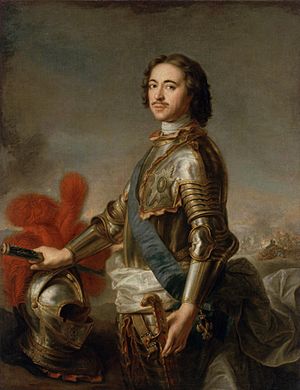
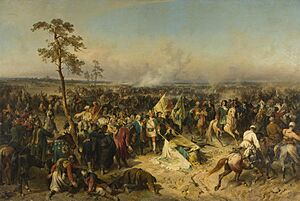
Peter the Great was a very important ruler who made many changes to Russia. He wanted Russia to be more like the countries in Western Europe. He fought many wars, including the Great Northern War against Sweden, which helped Russia gain access to the Baltic Sea. In 1721, he officially declared Russia an empire and became its first emperor.
Peter moved the capital from Moscow to a new city he built called Saint Petersburg. This new city was designed with European styles and showed his desire to modernize Russia. He also reorganized the government, creating a Governing Senate to help him rule. He changed how the Russian Orthodox Church was organized, making it more connected to the state. Peter encouraged science, trade, and education, helping Russia grow and develop.
During his reign, many people in Russia were serfs, who were like peasants tied to the land and had few rights. Peter's reforms, while modernizing Russia, also reinforced this system of serfdom.
Catherine the Great's Era (1762–1796)
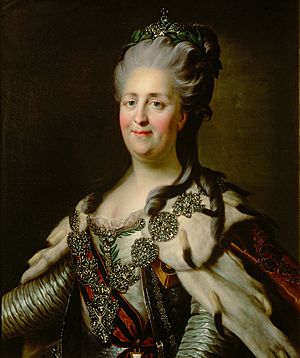
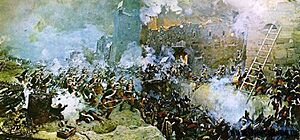
Catherine the Great was a German princess who became empress after taking power from her unpopular husband, Peter III. She continued Peter the Great's work of expanding and modernizing Russia. She gave more power to the nobles, which unfortunately meant that serfs had even fewer rights.
Catherine faced a large peasant uprising in 1773, where people demanded better treatment. She firmly put down the rebellion but also tried to make punishments less harsh. She even put a noblewoman on trial for mistreating serfs, which showed her interest in justice.
Under Catherine, Russia gained more territory through wars with the Ottoman Empire and by taking parts of Poland during the Partitions of Poland. Her rule helped Russia become a major European power and was a time of great cultural and intellectual growth.
Challenges in the 19th Century
In 1801, Catherine's son, Paul, was removed from power and died. His son, Alexander I, became emperor. Russia faced a huge challenge when Napoleon Bonaparte invaded in 1812. The harsh Russian winter and the Russians' strategy of burning their own land to deny resources to the invaders caused Napoleon's army to suffer greatly. Russian troops eventually chased Napoleon's forces all the way to Paris.
Despite this victory, Russia's economy lagged behind Western Europe because it still relied on serfdom. Alexander I considered reforms, but few major changes happened. His brother, Nicholas I, who became emperor in 1825, faced an uprising by liberal nobles and officers known as the Decembrist revolt. Nicholas quickly stopped the revolt and became a very strict ruler. To prevent more uprisings, the government increased control, watched people closely, and sent those who disagreed to distant labor camps in Siberia.
Russia also fought the Crimean War (1853–1856) against Britain, France, and the Ottoman Empire. Russia lost this war, which showed the weaknesses of its government and military.
Reforms and Further Expansion (Mid-19th Century)
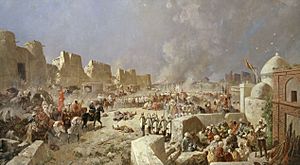
When Alexander II became emperor in 1855, many people wanted change. He decided to end serfdom from above, hoping to prevent a revolution from below. In 1861, he freed over 23 million serfs. This was a huge event, but the freed peasants often had to pay for their land over many years, and some felt they were still not truly free.
Russia continued to expand its territory, gaining land from China and taking control of much of Central Asia. In 1867, Russia sold Alaska to the United States. Many Americans initially thought this was a waste of money, calling it "Seward's Folly," but later, valuable resources were discovered there.
In the late 1870s, Russia fought another war with the Ottoman Empire in the Balkans, supporting Slavic people who were rebelling against Ottoman rule. Russia won the war, but the outcome at the Congress of Berlin in 1878 left some Russians unhappy.
In 1881, Alexander II was killed by a revolutionary group. His son, Alexander III, became emperor and was a very conservative ruler. He believed in strong traditional values and tried to protect Russia from ideas he thought were dangerous from Western Europe. During his reign, revolutionaries were hunted down by the secret police, and many were sent to Siberia. He also tried to make everyone in the empire adopt Russian culture and language, a policy known as Russification.
Early 20th Century and Collapse
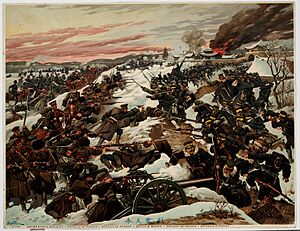
Nicholas II became emperor in 1894. He was committed to keeping the absolute power his father had, but he was not a strong leader. Russia's economy was growing, but many people, especially peasants and factory workers, still lived in poverty.
In 1904–1905, Russia fought and lost a war against Japan, which was a major blow to the government. This defeat, along with widespread discontent, led to the Revolution of 1905. On "Bloody Sunday" in January 1905, soldiers opened fire on peaceful protesters, killing many. This event sparked a general strike and demands for a more democratic government. Nicholas II reluctantly issued the October Manifesto, which promised a national parliament called the Duma. However, he later took back some of these promises, and the Duma had limited power.
When Russia entered World War I in 1914, it joined an alliance with France and Britain against Germany and Austria-Hungary. The war was very difficult for Russia. There were shortages of food and fuel, many soldiers were lost, and prices went up. The emperor took personal command of the army, leaving his wife, Empress Alexandra, in charge in the capital. She was influenced by a controversial monk named Grigori Rasputin, which further damaged the royal family's reputation.
By 1917, the situation was desperate. Mass protests and soldiers refusing to obey orders led to the February Revolution. Nicholas II gave up his throne, ending over 300 years of Romanov rule. A new Russian Provisional Government was formed, but it struggled to maintain order and continued Russia's involvement in the unpopular war. Later that year, the Bolsheviks took power in the October Revolution. The royal family was killed in July 1918. The Bolsheviks eventually established the Soviet Union, which covered most of the former Russian Empire's territory.
Territory and Geography
By the late 1800s, the Russian Empire covered about 22.4 million square kilometers, making it one of the largest countries in the world. Most of its people lived in the European part of Russia. The empire included over 100 different ethnic groups, with ethnic Russians making up about 45% of the population.
Russia's territory stretched from the Arctic Ocean in the north to the Black Sea in the south, and from the Baltic Sea in the west to Alaska in the east (before it was sold). It expanded into the Caucasus region, Central Asia, and parts of Poland and Finland.
For a time, between 1742 and 1867, the Russian-American Company managed Alaska as a colony. Russian settlers also established outposts as far south as California.
Government and Administration

From its beginning until the Russian Revolution of 1905, the Russian Empire was led by an emperor, also known as the tsar, who ruled with absolute power. This meant the tsar had almost unlimited authority.
After the 1905 Revolution, the government changed. The emperor agreed to limit his power by creating an elected parliament called the Imperial Duma. No new laws could be made without the Duma's approval. However, the emperor still had the right to dissolve the Duma and could veto any legislation. His ministers were only accountable to him, not to the Duma. So, while the emperor's power was limited, it remained very strong.
The government also included an Imperial Council, which acted as an upper house of the parliament, and a Council of Ministers led by a prime minister. The Most Holy Synod was the supreme body for the Russian Orthodox Church, which was the official state religion. The Governing Senate served as the highest court and had other administrative duties.
The empire was divided into many governorates and oblasts for local administration. Larger cities had their own administrative systems.
Economy
Before 1861, Russia's economy was mostly based on agriculture, with many peasants working as serfs on large estates. By 1897, about 95% of the population lived in the countryside.
After the abolition of serfdom in 1861, efforts were made to modernize the economy. Banks were created to provide loans to peasants and nobles. However, some policies, like increased taxes on peasants, contributed to a severe famine in 1891–1892, where many people died from starvation and disease.
Later, under Finance Minister Sergei Witte, the government increased its income through things like a monopoly on alcohol. By the early 1900s, a class of wealthier peasants began to emerge, and an income tax was introduced in 1916.
Russia also developed its mining and heavy industries, with significant output in gold, platinum, copper, and coal from regions like the Ural Mountains and southern Russia.
Infrastructure
The expansion of railways after 1860 had a big impact on Russia's economy and daily life. New rail lines, like the Transcaucasus Railway and the Trans-Caspian Railway, helped connect different parts of the empire, moved goods, and supported military needs. These railways also encouraged people to move to new areas.
Religion
The official state religion of the Russian Empire was Orthodox Christianity. The emperor was considered the supreme protector of this faith. The Most Holy Synod was the main governing body of the Russian Orthodox Church.
While Orthodoxy was dominant, the empire had many other religions, including Islam, Catholicism, Judaism, and Buddhism. The government generally tried to control non-Orthodox religions. For example, there were restrictions placed on Jewish communities, known as the Pale of Settlement, which limited where Jews could live and work. Some emperors tried to force Jews to adopt Christianity or become more integrated into Russian society. These policies led many Jews to leave Russia.
Muslim communities also faced challenges. While Catherine the Great initially allowed some religious freedom for Muslims, later policies became more restrictive. During the 1860s, after a long war in the Caucasus, many Circassian people faced great hardship. Large numbers were forced to leave their homes, and many lives were lost or changed forever as they sought new places to live. Other Muslim groups, like the Crimean Tatars, were also forced to move.
In 1905, Emperor Nicholas II issued an edict that gave more legal rights to non-Orthodox religions. However, some historians believe that the government and secret police may have encouraged violent attacks against Jewish communities, known as pogroms.
Society
Russian society was mostly rural, with 80% of people being peasants in 1913. Society was divided into different social classes, such as nobles, clergy, merchants, and peasants.
Serfdom and Peasants
Serfdom, a system where peasants were tied to the land and had few rights, was a major part of Russian society for centuries. Serfs worked for landowners, often in very difficult conditions. They could be sent to Siberia or forced into military service.
In 1861, Emperor Alexander II ended serfdom, freeing 23 million serfs. This was a huge change, but many former serfs remained poor. They received small plots of land, but often had to pay for them over many years, which kept them in debt. Many peasants had to rent land from their former masters to survive.
Some peasants moved to cities to work in factories, but they often kept ties to their home villages. The government tried to improve rural life with local assemblies called zemstvos, which helped with education and welfare.
Education
Education levels in the Russian Empire were generally low, especially compared to Western Europe. In 1800, only a small percentage of male peasants could read and write, though literacy was higher among nobles and city dwellers. The Russian Orthodox Church was often cautious about widespread education.
Under Emperor Alexander I, a national education system was created in the early 1800s. The country was divided into regions, with plans for universities, secondary schools, and primary schools. Many qualified teachers came from France. However, higher education remained mostly for a small elite.
Later, Emperor Nicholas I was more conservative about education, but his Minister of Education, Sergey Uvarov, still worked to improve universities. By 1900, there were more university students and specialized technical institutes. Students in cities like Moscow and Saint Petersburg often became involved in political demonstrations.
Images for kids
-
A watercolor-tinted lithograph from the 1840s, showing the arrival of the first Tsarskoye Selo Railway train at Tsarskoye Selo from St. Petersburg in 1837.
-
A painting from 1856 showing the procession of Emperor Alexander II into Dormition Cathedral in Moscow during his coronation.
-
Young Russian peasant women in front of a traditional wooden house (c. 1909 to 1915), a color photograph by Sergey Prokudin-Gorsky.
-
An 1856 painting imagining the announcement of the coronation of Alexander II.
-
The 1916 painting Maslenitsa by Boris Kustodiev, showing a Russian city in winter.
See also
 In Spanish: Imperio ruso para niños
In Spanish: Imperio ruso para niños




